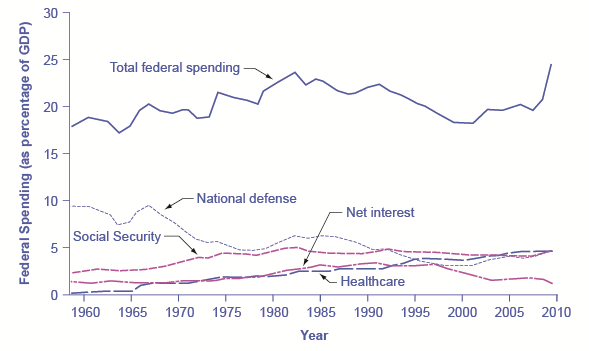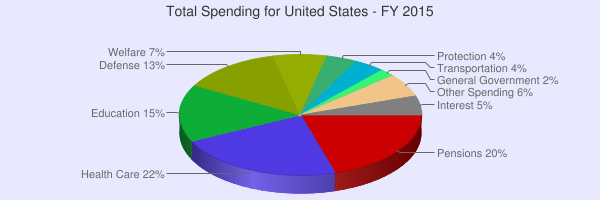3.16 政府开支经济学
章节大纲
-
The Economics of Government Spending
::政府开支经济学Government spending covers a range of services provided by the federal, state, and local governments. When the federal government spends more money than it receives in taxes in a given year, it runs a budget deficit . Conversely, when the government receives more money in taxes than it spends in a year, it runs a budget surplus . If government spending and taxes are equal, it is said to have a balanced budget . For example, in 2009, the U.S. government experienced its largest budget deficit ever as the federal government spent $1.4 trillion more than it collected in taxes. This deficit was about 10% of the size of the U.S. GDP in 2009, making it by far the largest budget deficit relative to GDP since the mammoth borrowing used to finance World War II.
::政府支出涵盖联邦、州和地方政府提供的一系列服务。当联邦政府在特定年份的税收支出超过其税收支出时,它就会出现预算赤字。相反,当政府税收收入超过其一年支出时,它就会出现预算盈余。 如果政府支出和税收相等,那么据说它的预算是平衡的。 例如,2009年,美国政府经历了有史以来最大的预算赤字,因为联邦政府的税收支出超过其税收支出的1.4万亿美元。 2009年,这一赤字相当于美国GDP规模的10%左右,成为自大规模借款用于二战以来相对于GDP的最大预算赤字。Universal Generalizations
::普遍化-
Government economic policies at all levels influence levels of employment, output, and price levels.
::各级政府的经济政策影响就业、产出和价格水平。 -
The role of the federal government has grown making it a vital player in the economy.
::联邦政府的作用日益增强,使其成为经济中的重要角色。
Guiding Questions
::问 问 问 问 问 问 问 问 问 问 问 问 问 问 问 问 问 问 问 问 问 问 问 问 问 问 问 问 问 问 问 问 问 问 问 问 问 问 问 问 问 问 问 问 问 问 问 问 问 问 问 问 问 问 问 问 问 问 问 问 问 问 问 问 问 问 问 问 问 问 问 问 问 问 问 问 问 问 问 问 问 问 问 问 问 问 问 问 问 问 问 问 问 问 问 问 问 问-
Why has the federal government’s role in the national economy grown over the last 100 years?
::为什么联邦政府在国民经济中的作用在过去100年中有所增长? -
Has the national government helped or hindered the nation’s economic growth since the 1940s?
::自1940年代以来,国家政府是否帮助或阻碍过国家的经济增长? -
How have current economic goals of the government impacted government spending?
::政府目前的经济目标如何影响政府开支?
Introduction to Government Budgets and Fiscal Policy
::介绍政府预算和财政政策Video: Government Shutdown: Locked Out of "Lady Liberty"
::影片:政府关闭:禁闭在“女性自由”之外- No Yellowstone Park?
So you had trekked all the way to see Yellowstone National Park in the beautiful month of October 2013, only to find it… closed. Closed! Why?
::所以在2013年10月的美丽月里,你一路跑到黄石公园 去看黄石公园 却发现它关闭了,为什么?For two weeks in October 2013, the U.S. federal government shut down. Many federal services, like the national parks, closed and 800,000 federal employees were furloughed. Tourists were shocked, so was the rest of the world: Congress and the President could not agree on a budget. Inside the Capitol, Republicans and Democrats argued about spending priorities and whether to increase the national debt limit. Each year's budget, which is over $3 trillion of spending, must be approved by Congress and signed by the President. Two-thirds of the budget is entitlements and other mandatory spending which occur without congressional or presidential action once the programs are set up. Tied to the budget debate was the issue of increasing the debt ceiling—how high the national debt of the U.S. government can be. The House of Representatives refused to sign on to the bills to fund the government unless they included provisions to stop or change the Affordable Health Care Act (more colloquially known as Obamacare). As the days ticked by, the United States came very close to defaulting on its debt.
::2013年10月,美国联邦政府关闭了两周。许多联邦机构,如国家公园、关闭和80万联邦雇员被解职。旅游者们震惊了,世界其他国家也震惊了:国会和总统无法就预算达成一致。在国会内部,共和党和民主党就支出优先事项和是否提高国家债务限额进行了争论。每年超过3万亿美元的支出预算必须由国会批准并由总统签署。三分之二的预算是权利和其他强制性支出,一旦制定方案,即发生没有国会或总统行动。在预算辩论中,增加债务上限的问题 — — 美国政府的国债可能有多高。众议院拒绝签署政府融资法案,除非它们包括停止或改变可负担的保健法(更称为奥巴马护理 ) 的规定。随着时间的流逝,美国将非常接近于拖欠债务。Why does the federal budget create such intense debates? What would happen if the United States actually defaulted on its debt? In this chapter, we will examine the federal budget, taxation, and fiscal policy. We will also look at the annual federal budget deficits and the national debt.
::为什么联邦预算会引发如此激烈的辩论?如果美国实际违约,会发生什么情况? 在本章中,我们将审视联邦预算、税收和财政政策。 我们还将审视年度联邦预算赤字和国家债务。All levels of government—federal, state, and local—have budgets that show how much revenue the government expects to receive in taxes and other income and how the government plans to spend it. Budgets, however, can shift dramatically within a few years, as policy decisions and unexpected events shake up earlier tax and spending plans.
::各级政府 — — 联邦、州和地方 — — 的预算都表明政府预期在税收和其他收入方面获得多少收入,以及政府计划如何使用这些收入。 但是,随着政策决定和意外事件动摇了以前的税收和支出计划,预算在几年内会发生急剧变化。Fiscal policy is one of two policy tools for fine-tuning the economy (the other is monetary policy). While monetary policy is made by policymakers at the Federal Reserve, fiscal policy is made by Congress and the President.
::财政政策是调整经济的两个政策工具之一(另一个是货币政策 ) 。 虽然货币政策是由联邦储备的决策者制定的,但财政政策是由国会和总统制定的。The discussion of fiscal policy focuses on how federal government taxing and spending affects aggregate demand. All government spending and taxes affect the economy, but fiscal policy focuses strictly on the policies of the federal government. We begin with an overview of U.S. government spending and taxes. We then discuss fiscal policy from a short run perspective; that is, how the government uses tax and spending policies to address recession, unemployment, and inflation; how periods of recession and growth affect government budgets; and the merits of balanced budget proposals.
::财政政策的讨论侧重于联邦政府的税收和支出如何影响总需求。所有政府支出和税收都影响经济,但财政政策严格侧重于联邦政府的政策。 我们首先从美国政府支出和税收的概览开始。 然后我们从短期的角度讨论财政政策;即政府如何利用税收和支出政策解决衰退、失业和通货膨胀问题;衰退和增长时期如何影响政府预算;平衡预算提案的好处。Total U.S. Government Spending
::美国政府支出共计Federal spending in nominal dollars (that is, dollars not adjusted for inflation) has grown by a multiple of more than 38 over the last four decades, from $92 billion in 1960 to $3.6 trillion in 2012. Comparing spending over time in nominal dollars is misleading because it does not take into account inflation or growth in population and the real economy. A more useful method of comparison is to examine government spending as a percent of GDP over time.
::以名义美元计算的联邦支出(即未按通胀调整的美元)在过去40年中增长了38倍以上,从1960年的920亿美元增长到2012年的3.6万亿美元,2012年的3.6万亿美元。 以名义美元对一段时间的支出进行比较是误导性的,因为它没有考虑到人口和实体经济的通货膨胀或增长。 比较方法更有用的方法就是审查政府支出在一段时间内占国内生产总值的百分比。The top line in 1 shows the level of federal spending since 1960, expressed as a share of GDP. Despite a widespread sense among many Americans that the federal government has been growing steadily larger, the graph shows that federal spending has hovered in a range from 18% to 22% of GDP most of the time since 1960. The other lines in 1 show the major federal spending categories: national defense, Social Security, health programs, and interest payments. From the graph, we see that national defense spending as a share of GDP has generally declined since the 1960s, although there were some upward bumps in the 1980s buildup under President Ronald Reagan and in the aftermath of the terrorist attacks on September 11, 2001. In contrast, Social Security and healthcare have grown steadily as a percent of GDP. Healthcare expenditures include both payments for senior citizens (Medicare), and payments for low-income Americans (Medicaid). Medicaid is also partially funded by state governments. Interest payments are the final main category of government spending shown in the figure.
::上列一行显示自1960年以来联邦支出水平,以占GDP的比例表示。尽管许多美国人普遍认为联邦政府一直在稳步增长,但图表显示,自1960年以来大部分时间,联邦支出一直徘徊在GDP的18%至22%之间。其他一行显示了联邦支出的主要类别:国防、社会保障、保健方案和利息支付。从图中可以看出,自1960年代以来,国防支出在GDP中的份额普遍下降,尽管在罗纳德·里根总统和2001年9月11日恐怖袭击之后,1980年代出现了一些上升的涨幅。相反,社会保障和保健支出在GDP中的比例稳步上升。医疗保健支出包括老年公民(医疗)和低收入美国人(医疗援助)的付款。医疗援助也由州政府提供部分资金。利息支付是图中显示的政府支出的最后主要类别。- Federal Spending, 1960–2010
Since 1960, total federal spending has ranged from about 18% to 22% of GDP, although it climbed above that level in 2009. The share spent on national defense has generally declined, while the share spent on Social Security and on healthcare expenses (mainly Medicare and Medicaid) has increased. (Source: Economic Report of the President , Tables B-80 and B-1, http://www.gpo.gov/fdsys/pkg/ERP-2013/content-detail.html)
::自1960年以来,联邦总开支占国内生产总值的约18%至22%不等,尽管在2009年超过了这一水平,但用于国防的份额普遍下降,而用于社会保障和保健支出(主要是医疗保险和医疗补助)的份额有所增加。 (资料来源:《总统经济报告》,表B-80和B-1,http://www.gpo.gov/fdsys/pkg/ERP-2013/content-detail.html)Each year, the government borrows funds from U.S. citizens and foreigners to cover its budget deficits. It does this by selling securities (Treasury bonds, notes, and bills)—in essence borrowing from the public and promising to repay with interest in the future. From 1961 to 1997, the U.S. government has run budget deficits, and thus borrowed funds, in almost every year. It had budget surpluses from 1998 to 2001, and then returned to deficits.
::政府每年向美国公民和外国人借钱以弥补其预算赤字。 政府这样做的方式是出售证券(货币债券、票据和账单 ) , 实质上是向公众借钱,并承诺在未来偿还利息。 从1961年到1997年,美国政府几乎每年都有预算赤字,因此几乎每年都有借钱。 1998年至2001年,它有预算盈余,然后又恢复到赤字。The interest payments on past federal government borrowing were typically 1–2% of GDP in the 1960s and 1970s but then climbed above 3% of GDP in the 1980s and stayed there until the late 1990s. The government was able to repay some of its past borrowing by running surpluses from 1998 to 2001 and, with help from low interest rates, the interest payments on past federal government borrowing had fallen back to 1.4% of GDP by 2012.
::20世纪60年代和70年代,联邦政府以往借款的利息支付额通常占国内生产总值的1%至2%,但随后在1980年代上升到GDP的3%以上,直到1990年代后期。 政府通过从1998年到2001年的盈余偿还了过去的部分借款,在低利率的帮助下,过去联邦政府借款的利息支付额在2012年下降到GDP的1.4 % 。We investigate the patterns of government borrowing and debt in more detail later in this unit , but first we need to clarify the difference between the deficit and the debt. The deficit is not the debt . The difference between the deficit and the debt lies in the time frame. The government deficit (or surplus) refers to what happens with the federal government budget each year. The government debt is accumulated over time; it is the sum of all past deficits and surpluses. If you borrow $10,000 per year for each of the four years of college, you might say that your annual deficit was $10,000, but your accumulated debt over the four years is $40,000.
::我们在这个单位中更详细地调查政府借款和债务的模式,但首先我们需要澄清赤字和债务之间的差别。赤字不是债务。赤字和债务之间的差别在于时间框架。政府赤字(或盈余)指的是联邦政府每年的预算情况。政府债务是长期积累的,是过去所有赤字和盈余的总额。如果每年为四年的大学学习贷款10 000美元,你可以说每年赤字是10 000美元,但四年累积的债务是40 000美元。
The U.S. Army 1st Armored Division conducts training operations at Fort Bliss, Texas.
::美国陆军第一装甲师在得克萨斯州布利斯堡开展训练行动。These four categories—national defense, Social Security, healthcare, and interest payments—account for roughly 71% of all federal spending, as 2 shows. The remaining 29% wedge of the pie chart covers all other categories of federal government spending: international affairs; science and technology; natural resources and the environment; transportation; housing; education; income support for the poor; community and regional development; law enforcement and the judicial system; and the administrative costs of running the government.
::这四个类别——国防、社会保障、保健和利息支付——约占联邦所有支出的71%,如2所示,其余29%的馅饼图包括联邦政府所有其他类别支出:国际事务;科学和技术;自然资源和环境;运输;住房;教育;穷人的收入支助;社区和地区发展;执法和司法制度;管理政府的行政费用。- Slices of Federal Spending, 2012
About 71% of government spending goes to four major areas: national defense, Social Security, healthcare, and interest payments on past borrowing. This leaves about 29% of federal spending for all other functions of the U.S. government. (Source: Economic Report of the President , Table B-80, )
::大约71%的政府支出用于四个主要领域:国防、社会保障、医疗保健和以往借款的利息支付。 这为美国政府所有其他职能留出了大约29%的联邦支出。 (资料来源:《总统经济报告》,表B-80, )In 2015 the total government expenditures, by all levels of government was $6.2 trillion. On a per capita, or per person basis that would have been $19,386 / person. The pie chart shows the total spending, or the percentage of spending by categories, for the US in fiscal year 2015.
::2015年,各级政府的政府支出总额为6.2万亿美元。 按人均或人均计算,人均支出为19 386美元/人。 派图显示了美国2015财政年度的总支出或按类别分列的支出百分比。Government spending is often described as spending in the "public sector" or the part of the economy that is made up of the federal, state, and local governments. Economists agree that government spending began to grow significantly during the Great Depression (1929-1939), and then grew exponentially during World War II. The economic crisis of the Great Depression and the programs instituted by Franklin D. Roosevelt, changed public opinion about what the government's role should be in everyday economic affairs. The success of the New Deal programs to provide relief, recovery, and reform for Americans, set the stage for the unprecedented growth in government spending. Over the years, many Americans have accepted the expansion of government spending as part of the increase in government regulation of the free market economy and the development of social programs since 1932.
::政府支出通常被描述为“公共部门”或由联邦、州和地方政府组成的部分经济的支出。 经济学家同意政府支出在大萧条期间开始大幅增长(1929-1939年),然后在第二次世界大战期间大幅增长。 大萧条的经济危机和富兰克林·罗斯福提出的方案改变了公众对政府在日常经济事务中应扮演的角色的看法。 新政方案成功地为美国人提供了救济、复苏和改革,为政府支出空前增长奠定了基础。 多年来,许多美国人接受政府支出扩张,作为1932年以来政府对自由市场经济的监管和社会方案发展的一部分。What the government does not provide, the private sector, or the part of the economy made up of private individuals and privately owned businesses, provides. So the economy is either categorized as either the public sector (government) or the private sector (not government).
::政府不提供什么,私营部门,或由私人和私有企业组成的经济部分提供什么。 因此,经济要么归为公共部门(政府),要么归为私营部门(而不是政府)。Types of Spending
::支出类型Spending is also termed expenditures, and the government spends money in the form of purchasing goods and services or as transfer payments. The government is a significant "consumer" in the private sector. It purchases vast amounts of goods to be used by its employees in its office such as computers, paper, copy machines or tables. It buys equipment for schools and universities, for the military and even for various departments that the government has created such as the Department of the Interior or the Department of Transportation. The government also provides services to the public by spending money to hire workers that staff the various departments, agencies, and the military.
::支出也称为支出,政府以购买货物和服务或转移支付的形式支出资金,政府是私营部门的重要“消费者”,政府购买大量物品供其办公室雇员使用,如计算机、纸张、复印机或桌子,为中小学和大学、军队甚至政府设立的各部门,如内政部或交通部购买设备,政府还向公众提供服务,花钱雇用各部门、机构和军队的工作人员。Transfer payments are another form of expenditure. Transfer payments are paid out to certain individuals, such as those who receive Social Security, disability for military service, welfare, or unemployment compensation. The government does not receive a good or service for these payments, however, the money that the government provides to these recipients makes it possible for them to participate in the economy.
::转移支付是另一种支出形式,向某些个人支付转移支付,如领取社会保障、服兵役残疾、福利或失业补偿的人,政府不因这些付款而获得任何福利或服务,然而,政府向这些受益人提供的款项使他们得以参与经济。Another type of transfer payment is known as a "grant in aid" where one level of government transfers money to another level of government. The federal government grants money to the states and local governments for specific purposes such as road construction, education, and urban renewal. The money generally has "strings attached" which means that it can only be spent for the reason that it was given and that recipient must follow the rules for how it is to be spent. If the money is not spent correctly, the money must be repaid to the federal government.
::另一种转移支付方式被称为“赠款援助”,政府一级将资金转给另一级别的政府。 联邦政府为道路建设、教育和城市改造等特定目的向州和地方政府提供资金。 这笔资金通常有“附加绳索 ” , 也就是说,它只能用于给付的原因,而且接受者必须遵循如何使用的规则。 如果资金没有正确使用,则必须偿还联邦政府。The size of the expenditures from "public sector" has an enormous impact on the allocation of resources. When the government spends money it impacts both state and local economies. If the government decides to fund a particular state program or local agency it can bring jobs and growth to that area, however, the opposite is also true. If the government cuts a program or ends funding for a project it may increase unemployment or impact a local economy.
::“公共部门”支出的规模对资源分配有着巨大影响。 当政府花费资金时,它会同时影响州和地方经济。 但是,如果政府决定为某个州方案或地方机构提供资金,它可以给该地区带来就业和增长,情况正好相反。 如果政府削减一个方案或结束对一个项目的资助,它可能会增加失业或影响地方经济。Another way that funding impacts the economy is the distribution of income. When the government increases or decreases transfer payments, it directly impacts those who receive those payments. If the government decides to spend money on defense and the military, then it can shift which part of the economy will benefit. In addition, the government can help a particular group that may be in need, such as farmers.
::融资影响经济的另一种方式是收入分配。 当政府增加或减少转移支付时,它会直接影响那些接受这些支付的人。 如果政府决定把资金花在国防和军队上,那么它就可以转移经济的哪个部分。 此外,政府也可以帮助某个可能需要帮助的群体,比如农民。Finally, some economists believe that the government can compete with the private sector when it provides goods and services. For example, public schools and universities compete with private educational facilities; or veteran's hospitals have the same health services that public hospitals provide.
::最后,一些经济学家认为,政府在提供商品和服务时可以与私营部门竞争。 比如,公立学校和大学与私立教育设施竞争;或者退伍军人医院拥有与公立医院相同的保健服务。Answer the self check questions below to monitor your understanding of the concepts in this section.
::回答下面的自我核对问题,以监测你对本节概念的理解。Self Check Questions
::自查问题1. Explain the term "public sector."
::1. 解释“公共部门”一词。2. Explain the term "private sector"
::2. 解释 " 私营部门 " 一词3. What is a transfer payment? What is the purpose of a transfer payment?
::3. 什么是转让付款?转让付款的目的是什么?4. Explain the term "grant in aid" and give an example of it.
::4. 解释 " 援助赠款 " 一词,并举一个例子。5. Federal government spending can impact local governments. Recently, the federal government has closed some military bases and reduced the size of the standing military. Go online and research the positive and negative aspects of federal spending on the El Paso economy and give examples.
::5. 联邦政府的支出可以影响地方政府:最近,联邦政府关闭了一些军事基地,减少了常备军队的规模,上网研究联邦支出对埃尔帕索经济的积极和消极方面,并举一些例子。 -
Government economic policies at all levels influence levels of employment, output, and price levels.



